Heat Transfer and Energy Systems
Activities on heat transfer and energy systems in the Department were initiated by Prof. Arcot Ramachandran in the 1960s as a pioneering initiative which led to the establishment of major programmes in energy research across the country. Today, the research group in thermal sciences and energy systems is the largest one in the Department, and has contributed significantly in basic and applied research. The newly founded Interdisciplinary Centre for Energy Research (ICER) at IISc emerged out of this group’s efforts. This centre handles some of the biggest projects in the Institute, namely the Indo-US solar consortium (SERIIUS), the National Centre for Combustion Research and Development (NCCRD) and the National Centre for Clean Coal Research and Development (NCCCRD).
Present activities in Prof. Pradip Dutta’s lab include development of cooling technologies (adsorption cooling, loop heat pipes, phase change materials) and development of high-temperature solar thermal receivers along with thermo-chemical storage technologies. Prof. R.V. Ravikrishna initiated combustion research activities, which was subsequently augmented by Prof. Saptarshi Basu’s lab. In this area, topics include spray dynamics and atomization, trapped vortex combustion, research on fuel injectors for gas turbine combustion, laser diagnostics, and combustion from levitated droplets. Prof. Pramod Kumar has developed India’s first supercritical CO2 (s-CO2) Brayton test loop for power generation and is developing micro-channel heat exchangers for s-CO2. Research on IC engines is being carried out by Dr. Himabindu and Dr. R.T. Naik. Dr. G.S.V.L. Narasimham’s lab works on cooling technologies and refrigeration. Our recent addition, Dr. Susmita Dash, specializes in microscale thermal transport.
In addition to fundamental research, the group has also actively collaborated with industries for technology development and translational research. Notable among them are development of s-CO2 turbomachinery with Triveni Turbines (Prof. Kumar), successful flight testing of loop heat pipe by ISRO (Prof. Dutta), development of molten salt based thermal storage loop with HPCL (Prof. Basu) and development of natural gas combustor for s-CO2 power cycle with GAIL (Prof. Ravikrishna).
Surface-engineering enabled enhancement of heat transfer
Boiling is an effective mode of heat transfer because of the high latent heat of vaporization utilized for conversion of liquid to vapor. The safe working limit, in terms of allowable heat flux and temperature conditions, in most practical applications such as boilers and power plants is restricted by the maximum heat flux – also known as the critical heat flux (CHF) – that can be removed safely from a surface. At heat fluxes beyond CHF, individual bubbles coalesce to form a continuous vapor blanket and transition to a film boiling regime occurs. The minimum surface temperature that supports formation of a continuous vapor film is termed as the Leidenfrost temperature. The Microscale Transport Laboratory is working on improving the thermal performance during quenching using surface engineering to enable rapid transition from film to nucleate boiling regimes. The enhancement of thermal performance by such modification of surface morphology will be attained by two means: first, by manipulating the geometry of the vapor film to enable higher rate of heat transfer during film boiling, and second, by increasing the Leidenfrost temperature to induce transition to nucleate boiling at higher surface temperatures. The lab is also working on the development of microheat pipes for applications in electronics cooling.
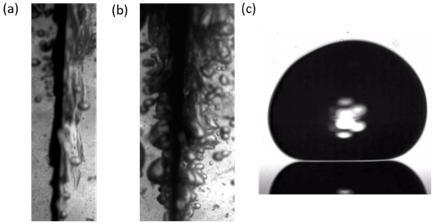
High-speed images of (a) film boiling mode and (b) nucleate boiling mode observed during quenching of a substrate inside liquid nitrogen, (c) a droplet in Leidenfrost state.
Development of antiscaling strategies for enhanced fluid-thermal transport
Crystallization-induced scaling poses operational and safety challenges in household as well as industrial applications, resulting in impaired heat transfer, flow blockage, and decreased equipment lifetime. Considering the pervasiveness of the scaling problem, developing antifouling strategies that can prevent the formation of scale and offset the negative influence of the dissolved salts on fluid and thermal transport is crucial. The Microscale Transport Laboratory is working on a fundamental understanding of the effect of presence of electrolytes on liquid-solid-vapor interactions and thermal and fluid transport. Passive (surface design-based) and active (acoustic and electric actuation-based) scale mitigation strategies are currently being investigated in the laboratory.

High-speed visual and infrared imaging showing the boiling behaviour of de-ionized water (left panels) and salt solution (right panels).
Development of India’s first s-CO2 Brayton test loop for power generation
Worldwide, there is a growing research thrust for developing waterless power plants. It is envisaged that supercritical CO2 (s-CO2) will replace steam as a working fluid in the next-generation power plants. The unique properties of s-CO2 such as single-phase operation with independent control of temperature and pressure in the supercritical phase coupled with excellent thermo-fluidic and heat transfer characteristics are paving the path for replacing water in power plants. Some of the above issues have been addressed by this research group through extensive theoretical analysis providing greater insights into s-CO2 power generation.
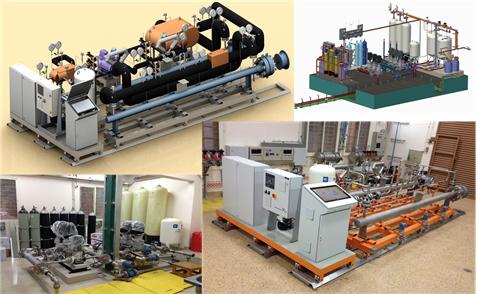
Supercritical CO2 test loop facility at IISc, Bangalore
In order to completely understand the underlying issues of s-CO2 and gain insight into developing the technology, this group has set up India’s first s-CO2 Brayton cycle test loop at a laboratory scale (with 150kW heat input). It is also the world’s first s-CO2 loop to be integrated with solar heat. The loop is completely designed in-house incorporating state-of-the-art instrumentation for enabling both fundamental and applied research. This loop is currently being used to perform fundamental studies on heat transfer and transport of s-CO2 and its mixtures and for development of critical components such as turbomachinery and compact heat exchangers. Funding for the project has been obtained from DST/IUSSTF, Govt. of India, as part of the Indo-US consortium Solar Energy Research Institute for India and the United States (SERIIUS).
The key research issues addressed using this facility are
- Thermodynamic analysis of s-CO2 Brayton power cycles
- Design for closed loop Brayton power cycles
- Fundamental studies on the understanding the control aspects of closed loop power cycles
- Methodology for energy dissipation in the absence of a turbo generator
Development of compact turbomachinery for s-CO2 Brayton cycle
High density of s-CO2 translates into an extremely compact power block making it ideal to be deployed directly on top of a solar tower. This improves the overall efficiency of power generation by reducing mechanical losses. Besides, the resulting reduction in piping length decreases pumping work and eliminates parasitic heat loss, thereby reducing the solar field area, a significant cost component of a concentrated solar thermal system. Furthermore, independent control of both temperature and pressure in the supercritical phase offers enormous flexibility for devising control algorithms based on source temperature variation ideally needed for Concentrated Solar Power (CSP) generation. Although s-CO2 may sound as a promising solution to address all shortfalls of a steam-based system, it has its own set of drawbacks, for e.g., the operating pressures are very high (low-side pressure of 73 bar and high-side pressure of 225 bar). Reduction in the volumetric flow rates (due to low specific volume of CO2 in supercritical phase) at the turbine inlet lead to very high shaft speeds making the turbomachinery design extremely challenging. The turbomachinery requires radical design changes compared to that for steam or gas turbines and involves fundamental understanding of the flow behaviour of s-CO2 across the turbine/compressor blade passages. Various turbine-compressor power block options for the test loop are being explored. The research group is in the process of developing a comprehensive mean-line code for turbine and compressor accounting for losses for developing blade profiles of s-CO2 turbo-machinery. This project is funded by the Ministry of New and Renewable Energy (MNRE), Govt. of India.
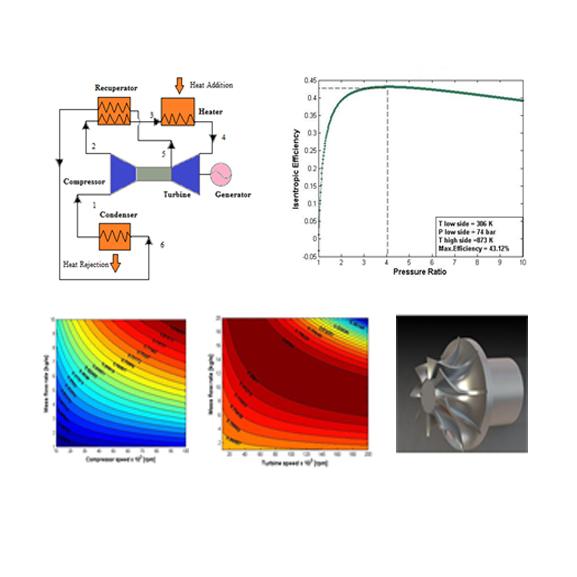
Mean-line analysis and preliminary CAD model of blade geometry for a 20kW s-CO2 developed using in-house design code.
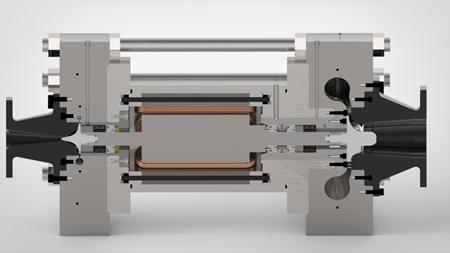
Detailed CAD model of turbomachinery.
Research issues identified and addressed are: 1) Turbomachinery scaling aspects, 2) Optimum blade profiles, estimating blade losses, and loading factors, 3) Generation of N-s D-s diagrams and correlation with other working fluids, and 4) Effect of shaft diameter and seal leakages in estimating windage losses in high speed turbomachinery.
Modelling of printed circuit heat exchangers (PCHE) for s-CO2 Brayton cycle
High-density CO2 in the supercritical phase offers a host of benefits for power generation. In addition to considerable reduction in size of the turbomachinery, s-CO2 is considered to be an excellent heat transfer fluid. The design of the heat transfer equipme nt is especially critical for Concentrated Solar Power (CSP) applications wherein the performance of the recuperator in the s-CO2 Brayton cycle is strongly influenced by fluctuations in insolation levels. The thermal cycling of the ensemble of the heat exchanger material and the resident s-CO2 diminishes the enthalpy of the working fluid at the entry to the receiver. It is necessary to minimize this effect to increase the power output of the plant. In particular, large variations in the specific heat of the low-pressure turbine exhaust tend to swing the net thermal capacity to large amplitude. A further complication arises because of variations in the heat transfer coefficients of the hot and cold fluid streams. Preliminary analysis suggests that PCHEs are preferred when the amplitude of temperature transients is small.
The research focuses on the comparative evaluation of a PCHE and a tube-in-tube configuration of the recuperator for s-CO2 Brayton cycle. During the course of this work comprehensive computational/analytical tools have been developed to model the flow behaviour of s-CO2 in the PCHE. The output from the modelling can be complemented and verified experimentally using the s-CO2 test loop developed at IISc. Funding for this project has been obtained from DST/IUSSTF, as part of the Indo-US consortium project SERIIUS.
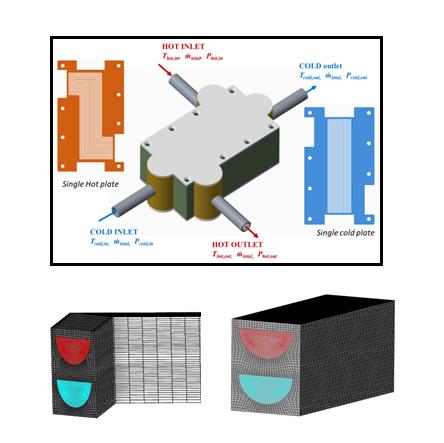
Printed circuit heat exchangers (schematic and models).
Development of high-temperature solar receivers
Concentrate Solar Power (CSP) systems need high thermodynamic efficiencies in order to be economically viable. To improve the efficiency, the system should work at high temperature which suitably needs high solar flux. In order to fulfil this requirement, the design of the receiver absorbing the concentrated solar flux needs special attention. Designing a high temperature solar receiver is a complex multiphysics problem involving multiple length scales and intricate thermofluidic interactions. The research group has developed a coupled modelling methodology to accurately model the optical-thermal-fluid-structural interaction for solar receivers. Following detailed modelling and evaluation, a tubular receiver designed for s-CO2 was manufactured and demonstrated on-sun in collaboration with Sandia National Laboratories, USA. The group has also executed a number of projects for addressing the challenges in cavity solar receivers. For enabling operation at high temperatures (fluid outlet ~ 1000 °C), the group has collaborated with Bharat Heavy Electricals Ltd. (BHEL) for using high-temperature ceramics. Reticulated and structured porous matrices made with newly developed materials have been characterized and used for design and testing of novel hybrid cavity-volum etric receivers. Funding for this project has been obtained from DST/IUSSTF as part of the Indo-US consortium project SERIIUS, MNRE and BHEL.
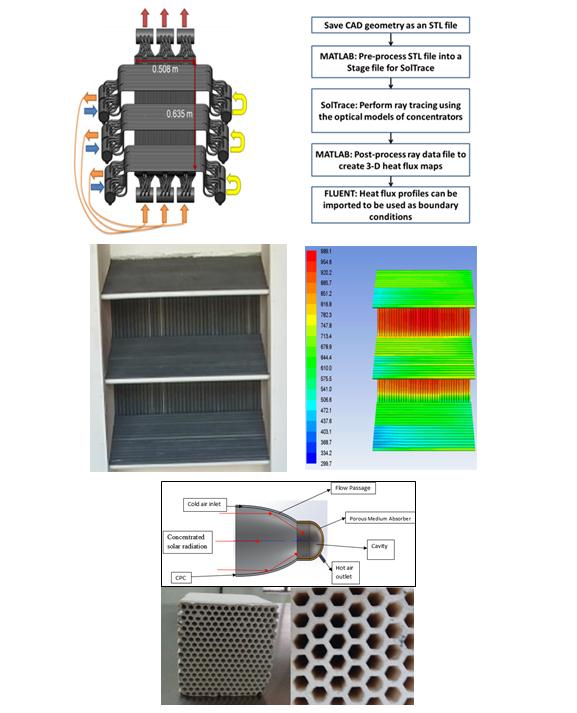
Receiver development in collaboration with Sandia National Laboratories and BHEL.
Thermal evaluation of a PCM-coupled heat pipe for space craft thermal management
One way of managing the issue of varying heat loads without overdesigning the spacecraft thermal control system is to use a Phase Change Material (PCM) coupled with a heat pipe that is connected to the spacecraft’s external thermal radiator. During a sudden increase in thermal load, heat would be absorbed by the PCM in the form of latent heat, followed by a slow discharge of heat throu gh the heat pipe to the radiator.
This group has developed an analytical tool for modelling and designing a PCM canister module for an axially grooved ammonia heat pipe used in a space craft. The PCM canister stores heat from the electronic devices during the brief transient peaks and slowly releases it to the heat pipe during idle cycle time. A thermal network model is developed considering the geometrical aspects of the PCM canister and the thermophysical properties of the PCM material. The model accounts for the latent heat stored in the PCM on account of phase change and the thermal resistances across various interfaces between the PCM canister and the heat pipe ensemble.
The model is comprehensive accounting for the various thermophysical phenomena across all length scales including the phase change process. The model has been extensively refined and validated based on the measurements obtained from carefully tailored experiments. The PCM coupled heat pipe shows ~ 31% decrease in the peak temperature of the heat pipe due to storage of heat in the PCM compared to the conventional heat pipe under identical operating conditions. A two-fold increase in the operating time span of the heat pipe is observed due to the presence of the PCM, thus making PCM-coupled heat pipe an ideal candidate for applications with unsteady heat loads.
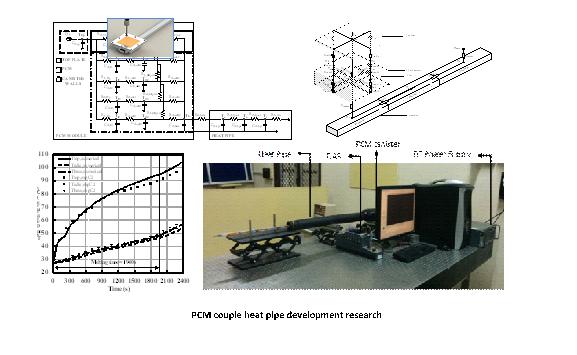
The design tool has been shared with scientists from Indian Space Research Organisation (ISRO). Based on the current research, ISRO has plans for implementing it in geo-stationary satellites in the near future. This project is funded by ISRO.
Solidification in materials processing
The National Facility for Semi-Solid Forming (NFSSF) was set up at IISc in 2004, with funding from the Ministry of Mines, Department of Science and Technology (DST), and Defence Research & Development Organization (DRDO), for indigenous development of semi-solid processing technology. An interdisciplinary team, comprising scientists from Mechanical Engineering and the Electrical Engineering departments, had undertaken a study and developed the technology involving electromagnetism (for linear inductive coil design), computer-aided geometric modelling, and CFD modelling of the electromagnetic stirring process during direct chilled casting of semi-solid billets. The project has led to the indigenous development of a billet casting process for producing aluminium alloys with non-dendritic microstructure for the first time in India. The team has indigenously developed a linear electromagnetic stirrer for producing aluminium billets with globular non-dendritic microstructure in a consistent manner. Subsequently, during 2008-2012, there was a consortium project involving NFSSF (IISc) and several Indian automobile companies (TVS Motors, Mahindra & Mahindra, Sundaram Clayton Ltd.) under the CAR programme of TIFAC. With the in-house billet making capability, the team successfully produced net-shaped automotive components through the thixocasting route for the first time in India.
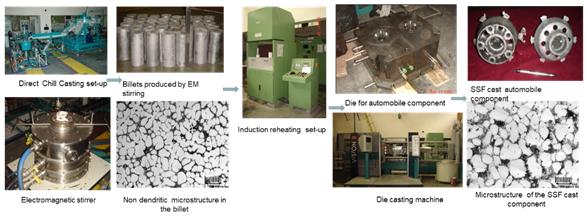
Thixocasting process developed at IISc.
Adsorption-based solar cooling cum desalination system
Development of an experimental prototype of solar cooling stems from rural India’s need for refrigeration. This is crucial for short-term preservation of agro-produce and lifesaving medicines. Concurrently, the system should use predominantly low-grade thermal energy (<100°C) instead of relying solely on electricity. Silica gel with water adsorption was found to be a potential route as such a system can operate with 75-85°C heat. These temperatures are easily achievable by non-concentrating type of solar collector, making it potentially cheaper.
The team has developed and demonstrated a lab-scale 2-stage silica gel adsorption system using solar waste heat to desalinate water and simultaneously produce cooling. The system works on the principle of thermal compression realized using 4 silica-gel adsorber beds in each stage, which are cyclically cooled by water at ambient temperature during adsorption, and heated by hot water discharged from an array of solar collectors at 70-80°C during desorption of water vapor. This low-pressure steam which is flash evaporated in the evaporator at 10°C is compressed to the condenser pressure of ~ 20 kPa by means of 2-stage thermal compression which in a traditional refrigeration system is achieved by means of a mechanical compressor. The condensed water is free of dissolved salts and can be pumped out thus providing desalinated water for drinking needs. Based on the perform ance outcome of the two-stage laboratory-scale prototype (1 kW cooling capacity with dual effect of cooling and desalinated water), a cost-effective scaled-up field unit (10 kW cooling capacity) was built on the roof top of ICER building. The entire funding for the project was provided by DST, Govt. of India.
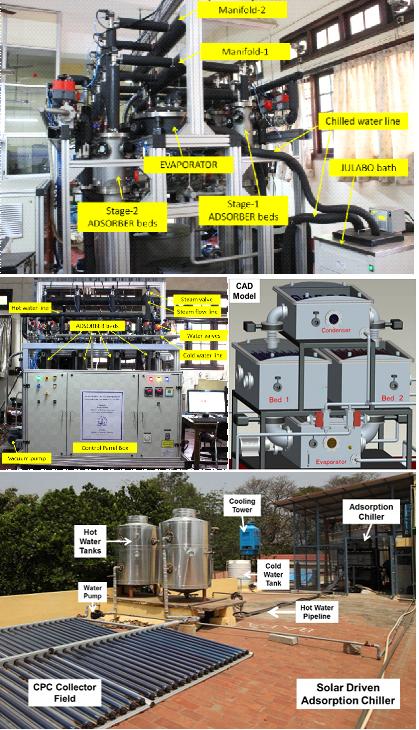
Lab-scale prototype and scaled up field unit
High-speed electric generator for supercritical CO2 turbomachinery
The turbo-machinery shaft speeds of supercritical CO2 (s-CO2) turbines are in the order of 10,000-50,000 rpm for sub-megawatt level of power generation. Conventional electric generators typically run at speeds not exceeding 3000 rpm. The proposed project attempts to develop high-speed electrical generators for direct-coupled operation with such turbo-machinery for cost and efficiency considerations. The rotor of a Switched Reluctance Generator (SRG) is suitable for high-speed and high-temperature applications as it is robust, simple, permanent magnet-free, and carries no current.
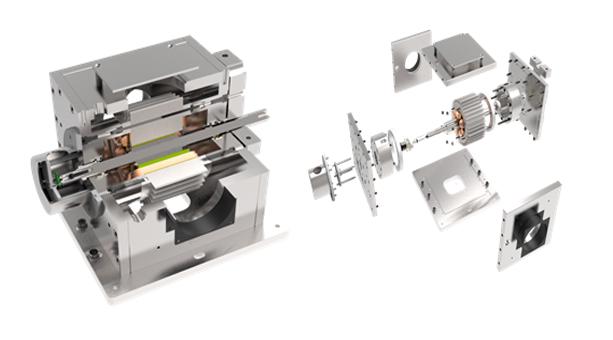
Switch reluctance motor (assembly and exploded view) developed in-house.
From a mechanical design perspective, high-speed machines are susceptible to high structural and dynamic loads leading to premature failures. The rotor design needs careful evaluation of static dynamic loads. This would involve rigorous FEA analysis incorporating intricate geometric rotor details followed by precisely tailored experiments to capture the modal frequencies of the rotor to ensure a safe design for high-speed operation. In addition to the structural design of the SRG, the machine is subjected to high thermal loads due to large currents being generated in the stator coil windings of the SRG. A poor thermal design would not only lead to additional thermal stresses on the machine but also would be imperative from an electrical design perspective. Higher operating temperatures adversely affect the magnetic permeability of the material leading to deterioration in SRG performance and output.
High-speed (10,000-50,000 rpm, 2-20 kW) SRG are being developed under this project. This includes design, fabrication and electrical performance evaluation of SRG, and structural and dynamic analysis of rotor, besides power converter and novel control strategies.
Th e aim is to translate and leverage existing capabilities in mechanical and electrical engineering to develop high-speed generators to address urgent needs in the areas of energy conversion and renewable energy. This project is funded by IMPRINT.
Research issues addressed:
- Hydrodynamic analysis of gas film bearings
- High shear flows in thin film labyrinth seals and bearings
- Fundamental studies on differential pressure gas pressure seals
- Externally pressurized temperature compensated gas film bearings
- Active damping control in high speed bearings and seals
- Rotor dynamic studies in high speed turbomachinery and generators
Combustion and Spray Research
This group addresses several topics related to the fundamental study and application of combustion and spray processes. A few highlights are illustrated below:
- A high-pressure spray chamber with optical access has been indigenously designed and commissioned which is a unique facility in the country. This facility has enabled optical characterization of sprays under realistic conditions of pressure and temperature (60 bar, 900 K). Spray characteristics of biofuels such as pure plant oils of pongamia and jatropha have been measured for the first time. Specifically, droplet sizes, spray cone angle and spray tip penetration have been reported. The results indicate markedly inferior atomization as compared to conventional fuels such as diesel, necessitating the need for alternate strategies and fuel injection system redesign.
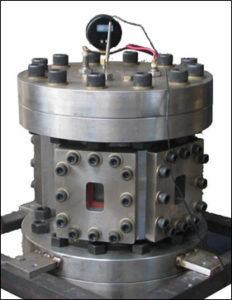
High-pressure spray chamber fabricated indigenously.
- Novel atomization methods for high viscosity biofuels are being developed. These include effervescent atomization and other twin-fluid methods such as air-assisted atomization in which kinetic energy of air is used to aid the liquid atomization. In most studies, either an annular/central liquid sheet is blasted with air jets, or the gas is allowed to mix with the liquid inside the atomizer to form the spray. On the other hand, impinging jet atomizers are used in applications such as bipropellant rocket engines and chemical processes which require rapid mixing between two fluids. A novel strategy consisting of impinging jets along with air-assist has been studied to take advantage of both methods.
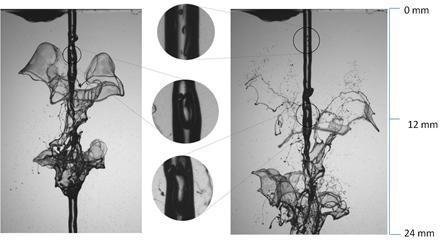
Air-assisted atomization of plant oil biofuels.
- Fundamental work on compact combustor development based on the Trapped Vortex Combustor (TVC) concept for small gas turbine applications has shown promising results. The figure below right shows a versatile optically accessible combustor rig designed for studies with gaseous fuels. Results indicate that cavity injection strategies play a major role in flame stability. Detailed experiments indicate that blow-out occurs for a certain range of cavity air flow velocities. The phenomenon of flame blow-out at certain intermediate cavity air velocities is explained on the basis of transition from a cavity-stabilized mode to an opposed flow stagnation mode. A novel strategy is proposed for achieving flame stability at all conditions. This involves using a flow guide vane in the path of the main flow to direct a portion of the main flow into the cavity. This seems to result in a desirable dual vortex structure, i.e., a small clockwise vortex behind the vane and large counterclockwise vortex in the cavity. Experimental results show stable flame at all flow conditions with the flow guide vane, and pressure drop is estimated to be within acceptable limits. For improving the mixing and combustion efficiency, an inclined strut configuration is implemented based on insights from numerical simulations. Experiments indicate that performance of this configuration is favorable with respect to all combustor parameters such as stability, pressure drop, exit pattern factor, combustion efficiency and emissions.
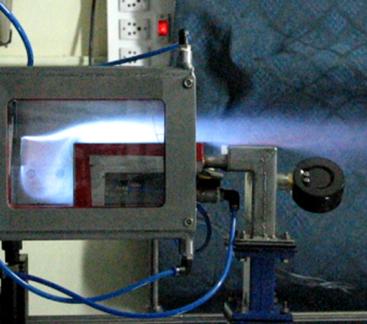
Trapped vortex combustor facility in operation.
Design and development of novel fuel injectors for gas turbine combustion
The primary objective of this study is to quantitatively understand the parameters governing the spray formation processes in coaxial swirl injector. The knowledge of injector flow field aerodynamics is mandatory in the assessment of gas turbine injectors. This is because if any of the frequencies induced by injector flow field is inconsistent with acoustic modes, there may be potential for thermoacoustic oscillations as per Rayleigh criterion. The global characteristics and dynamics of vortex breakdown modes, breakup dynamics of liquid sheet, flow-droplet interactions, the influence of swirl geometrical parameters in high shear swirl cup, and the identification of energetic flow instability modes and their characteristic frequency signature have been meticulously addressed in this study.

(Left) Atmospheric pressure spray rig; (Right) Atmospheric pressure multiple swirler rig.
Sprays and Combustion instabilities
Stringent environmental regulations clamped on gas turbine industry demanding low NOx emission have forced the manufacturers to adopt ultra-lean combustion techniques. Employing swirl flows is one such technique adopted for achieving lean burning. Besides, swirl also serves as a method of flame stabilization. Swirl-stabilized flames are, however, susceptible to combustion instabilities or thermoacoustic instabilities. Understanding th ese instabilities mandates a comprehensive and rigorous analysis of dynamic coupling of flame heat release fluctuation, burner acoustics and incident velocity perturbations. The dynamics of flame heat release depends on the intensity of swirl imparted, surface area fluctuation, fuel-dependent chemical kinetics, flow-field properties like vortex shedding, etc.

Transformation in flame structure with increase in swirl intensity.
The transformation in time-averaged flame structure with stepwise increase in swirl intensity was reported. In particular, primary transition consisted of a transformation from zero-swirl straight jet flame to lifted flame with blue base, and finally to swirling seated flame. In addition, a secondary transition from swirling seated flame to swirling flame with a conical tailpiece, and finally to highly-swirled near-blowout ultra-lean flame was also reported.
Surface Patterning
A low-cost patterning technique that eliminates the more expensive methodologies presently in practice is studied. Using a simple document, two-dimensional mm-scale “wall-less confinement” using ink-based hydrophobic fence is printed on a plasma-treated superhydrophilic surface and the confinement is filled with nanocolloidal liquid(s). Using the confinement geometry, the 3D shape of the droplet is controlled to exhibit multiple interfacial curvatures. The droplet in the “wall-less confinements” evaporates naturally , exhibiting unique curvature-induced flow structures which leads to self-assembly of nanoparticles into functional patterns. This technology with functional colloids has widespread applicability in domains like nano-electronics, photonic crystals, pharmaceutics, semi-conductors, and photovoltaics among others.

Wall-less confinement architecture for nano-colloid patterning.
Internal Combustion Engines
Research topics of interest include the study of injection strategies, novel ignition concepts, and performance and emission characteristics for advanced/lean combustion.
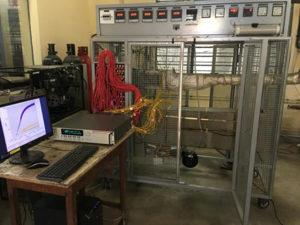
Experimental setup of automotive thermoelectric generator for conducting pseudo-transient analysis.
The group has undertaken the study of well-to-wheel greenhouse gas emissions, energy efficiency evaluation of various conventional and alternate fuel vehicles (including hydrogen) in the Indian context, concept evaluation of waste heat recovery from combustion exhaust gases, plasma ignition and other lean combustion concepts. Collaborative projects with agencies like Karnataka State Road Transport Corporation (KSRTC), Bangalore Metropolitan Transport Corporation (BMTC), Bio-fuel Technology, General Electric (GE), Relon Ltd., Bio-Earth Power, Indian Oil Corporation Ltd. (IOCL) have been undertaken aimed at reducing harmful engine emissions and greenhouse gases with particular emphasis on the transport sector.
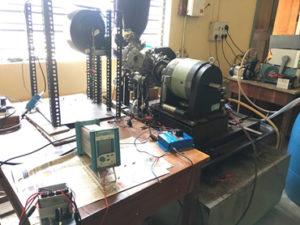
Small SI Engine experimental setup for conducting plasma ignition and other lean combustion concepts .
Diesel engine performance with alternate Bio-fuels
Heavy dependence on conventional fossil fuels and its volatility in terms of supply and prices causes a deep impact on a nation’s progress. The increasing use and dependence on conventional energy sources has led to a sharp increase in the demand for electricity and fossil fuels across the globe. The steep increase in the price of energy is seen to hinder the development of energy-dependent countries like India. Added to this are the environmental concerns and growing world pressure on reaching an international consensus for curbing Greenhouse Gas (GHG) emissions. It is also evident that the uncertainty of energy supplies will only grow in the near future due to the complex dynamics of demand and supply which adds to the volatility of oil prices in world energy markets.
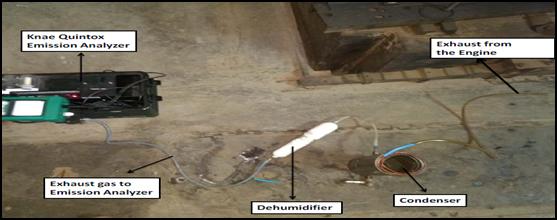
Experimental setup with emission analyzer coupled to dehumidifier and condenser.s
The principle objective of Dr. Naik’s research group is the enhance the combustion aspects by reducing the emission with considerable good output power. They serviced the engine shown below, prepared a suitable load bank capable of loading the engine up to 5kW, undertaken throughout sourcing and fitted necessary safety circuitry. Ethanol diesel blends were prepared using a two-step procedure. As part of the experiment, the engine was operated at different load conditions and fueled with D100 as well as ethanol diesel blends with multiple concentrations. Ethanol diesel blends were observed to provide a higher BSFC and lower BSEC but better thermal efficiencies when compared with D100. Emission readings were recorded using Kane Quintox emission analyzer. A significant decrease in NOx, CO and UHC emissions was observed for ethanol blends.
